Management Accounting Report: Financial Problem Solving at TPG
VerifiedAdded on 2022/11/28
|12
|3487
|462
Report
AI Summary
This report provides a comprehensive analysis of management accounting principles, tools, and systems, focusing on their application within TPG Processing. The report begins with an overview of management accounting, covering its principles, role, and essential elements of different systems. It then delves into various methods used for reporting, including budgeting and variance analysis. The report also explores the integration of management accounting within TPG Processing, highlighting the benefits such as improved cash flow and reduced expenses. Part B of the report examines the advantages and disadvantages of different planning tools used for budgetary control, such as budgets, cost accounting, and cash flow analysis. Furthermore, it discusses different planning tools like benchmarking and KPIs and their application in preparing and forecasting budgets. Finally, the report addresses how management accounting systems can be used to respond to financial problems and contribute to the sustainability of the business through cost management and strategic planning.
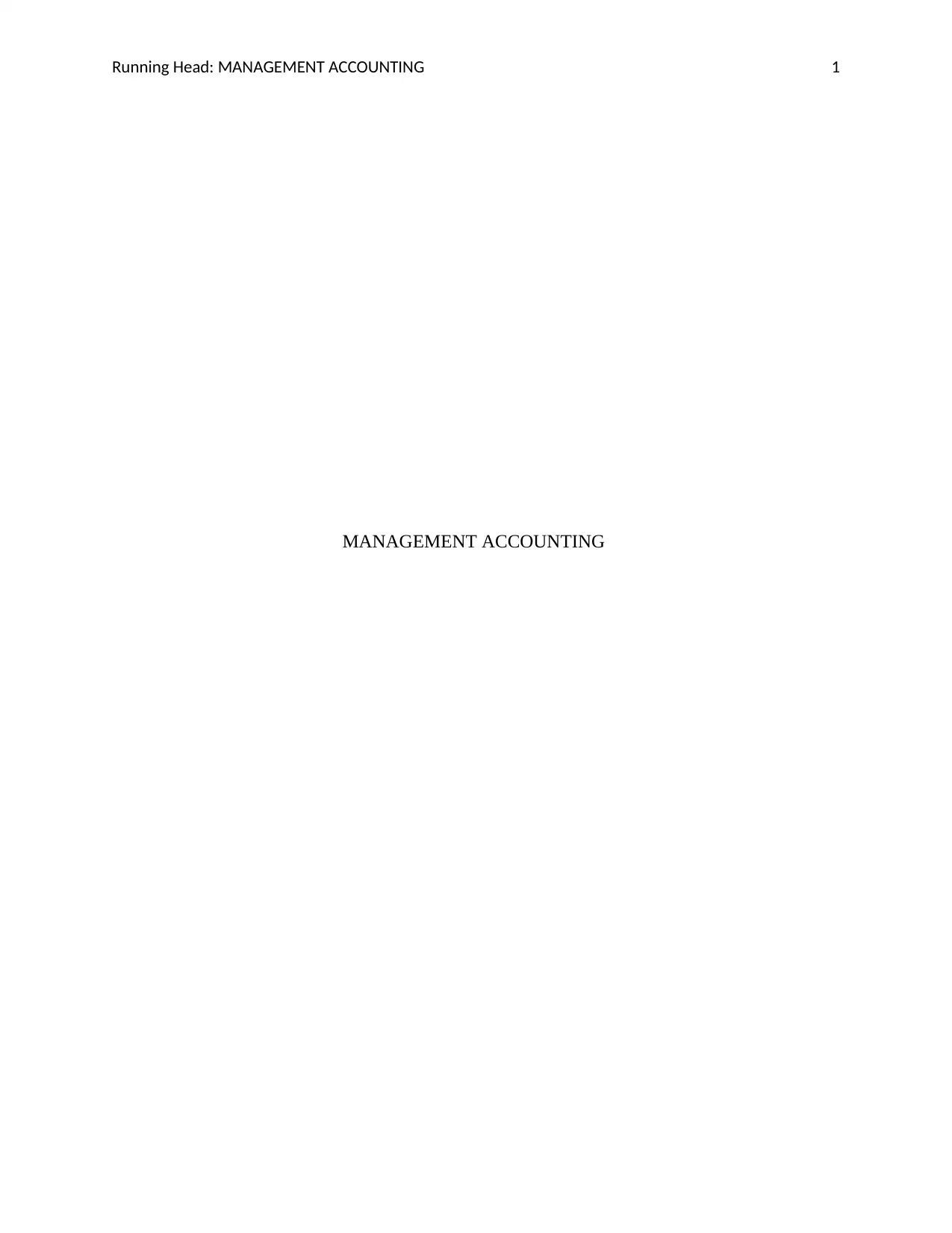
Running Head: MANAGEMENT ACCOUNTING 1
MANAGEMENT ACCOUNTING
MANAGEMENT ACCOUNTING
Paraphrase This Document
Need a fresh take? Get an instant paraphrase of this document with our AI Paraphraser
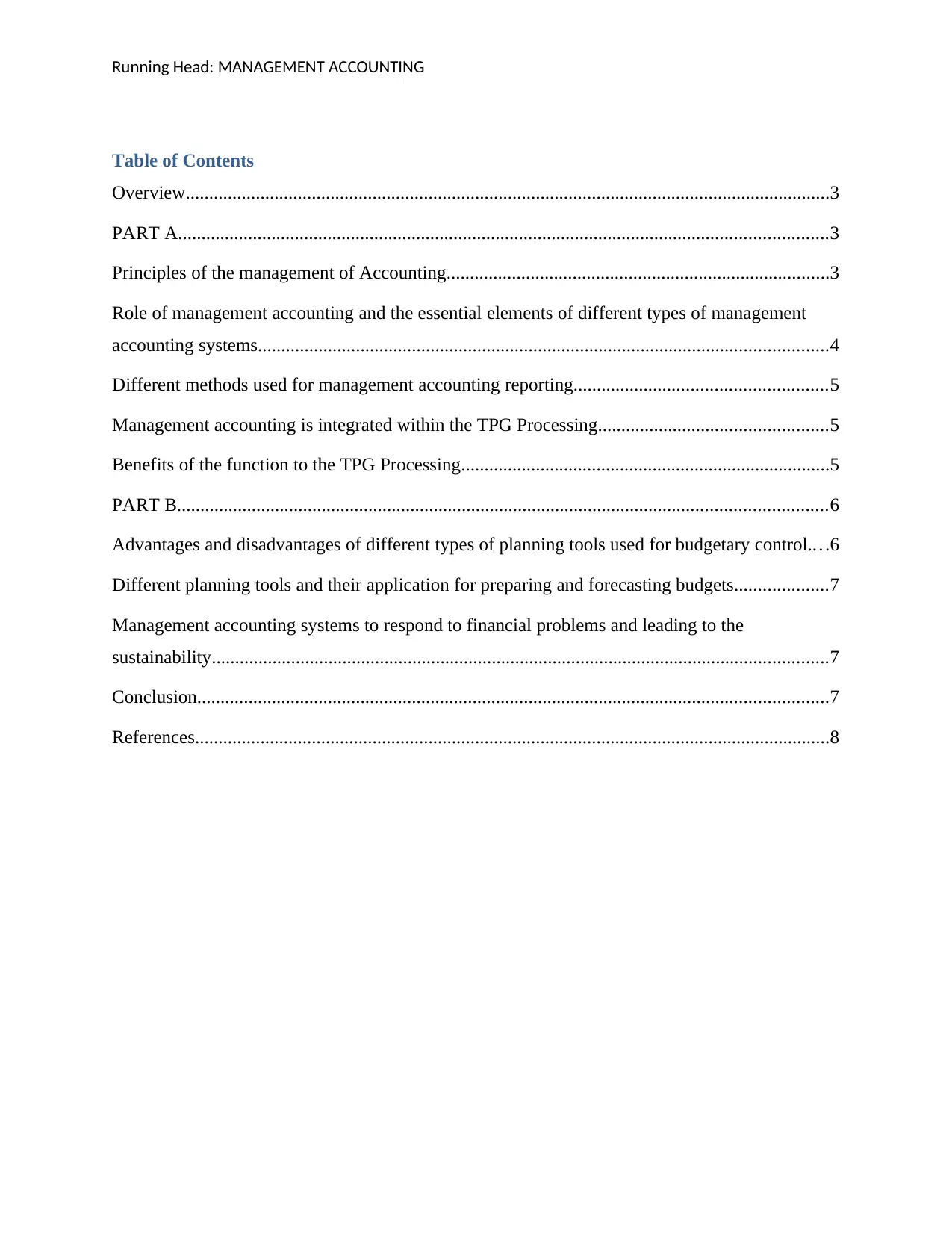
Running Head: MANAGEMENT ACCOUNTING
Table of Contents
Overview..........................................................................................................................................3
PART A...........................................................................................................................................3
Principles of the management of Accounting..................................................................................3
Role of management accounting and the essential elements of different types of management
accounting systems..........................................................................................................................4
Different methods used for management accounting reporting......................................................5
Management accounting is integrated within the TPG Processing.................................................5
Benefits of the function to the TPG Processing...............................................................................5
PART B...........................................................................................................................................6
Advantages and disadvantages of different types of planning tools used for budgetary control....6
Different planning tools and their application for preparing and forecasting budgets....................7
Management accounting systems to respond to financial problems and leading to the
sustainability....................................................................................................................................7
Conclusion.......................................................................................................................................7
References........................................................................................................................................8
Table of Contents
Overview..........................................................................................................................................3
PART A...........................................................................................................................................3
Principles of the management of Accounting..................................................................................3
Role of management accounting and the essential elements of different types of management
accounting systems..........................................................................................................................4
Different methods used for management accounting reporting......................................................5
Management accounting is integrated within the TPG Processing.................................................5
Benefits of the function to the TPG Processing...............................................................................5
PART B...........................................................................................................................................6
Advantages and disadvantages of different types of planning tools used for budgetary control....6
Different planning tools and their application for preparing and forecasting budgets....................7
Management accounting systems to respond to financial problems and leading to the
sustainability....................................................................................................................................7
Conclusion.......................................................................................................................................7
References........................................................................................................................................8
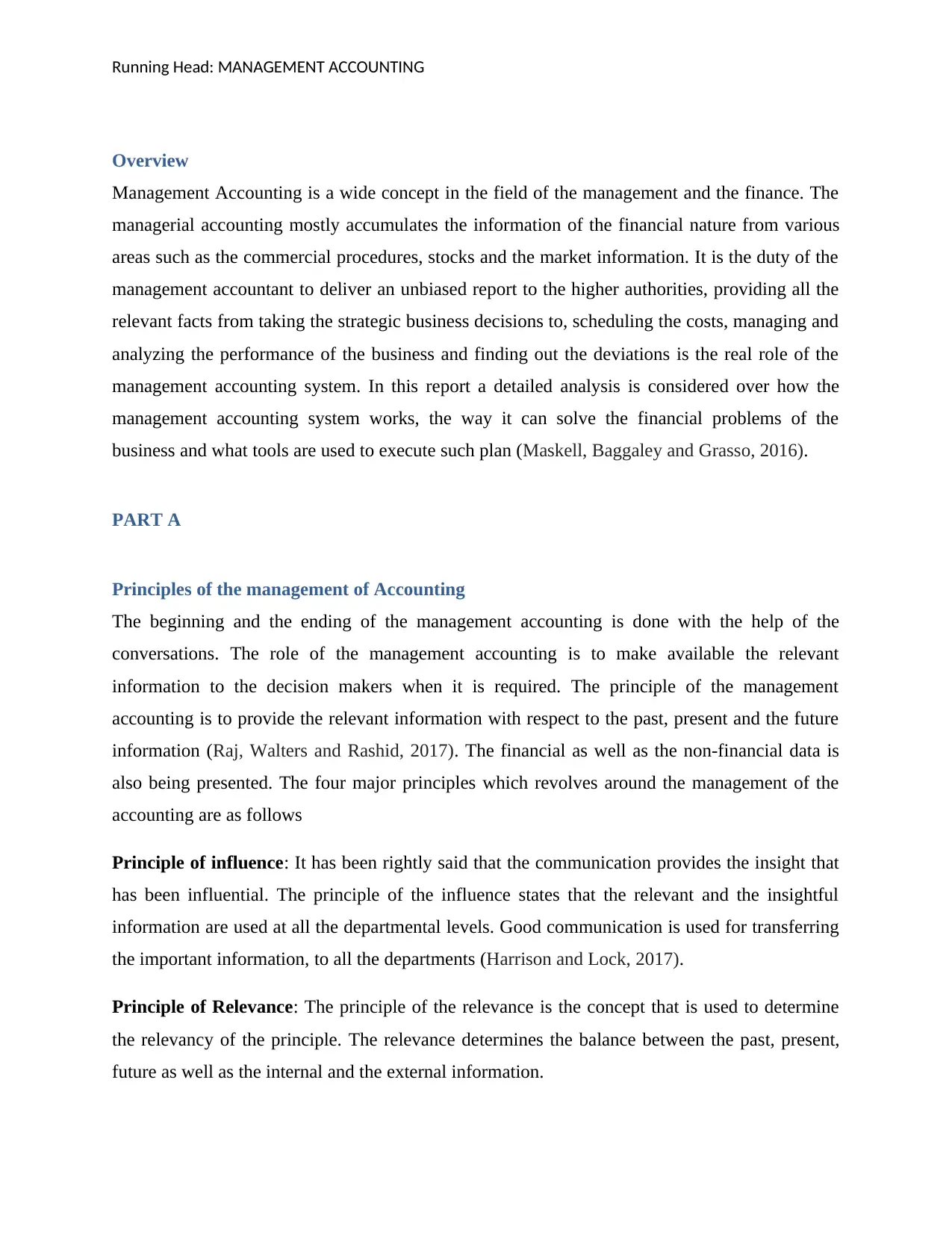
Running Head: MANAGEMENT ACCOUNTING
Overview
Management Accounting is a wide concept in the field of the management and the finance. The
managerial accounting mostly accumulates the information of the financial nature from various
areas such as the commercial procedures, stocks and the market information. It is the duty of the
management accountant to deliver an unbiased report to the higher authorities, providing all the
relevant facts from taking the strategic business decisions to, scheduling the costs, managing and
analyzing the performance of the business and finding out the deviations is the real role of the
management accounting system. In this report a detailed analysis is considered over how the
management accounting system works, the way it can solve the financial problems of the
business and what tools are used to execute such plan (Maskell, Baggaley and Grasso, 2016).
PART A
Principles of the management of Accounting
The beginning and the ending of the management accounting is done with the help of the
conversations. The role of the management accounting is to make available the relevant
information to the decision makers when it is required. The principle of the management
accounting is to provide the relevant information with respect to the past, present and the future
information (Raj, Walters and Rashid, 2017). The financial as well as the non-financial data is
also being presented. The four major principles which revolves around the management of the
accounting are as follows
Principle of influence: It has been rightly said that the communication provides the insight that
has been influential. The principle of the influence states that the relevant and the insightful
information are used at all the departmental levels. Good communication is used for transferring
the important information, to all the departments (Harrison and Lock, 2017).
Principle of Relevance: The principle of the relevance is the concept that is used to determine
the relevancy of the principle. The relevance determines the balance between the past, present,
future as well as the internal and the external information.
Overview
Management Accounting is a wide concept in the field of the management and the finance. The
managerial accounting mostly accumulates the information of the financial nature from various
areas such as the commercial procedures, stocks and the market information. It is the duty of the
management accountant to deliver an unbiased report to the higher authorities, providing all the
relevant facts from taking the strategic business decisions to, scheduling the costs, managing and
analyzing the performance of the business and finding out the deviations is the real role of the
management accounting system. In this report a detailed analysis is considered over how the
management accounting system works, the way it can solve the financial problems of the
business and what tools are used to execute such plan (Maskell, Baggaley and Grasso, 2016).
PART A
Principles of the management of Accounting
The beginning and the ending of the management accounting is done with the help of the
conversations. The role of the management accounting is to make available the relevant
information to the decision makers when it is required. The principle of the management
accounting is to provide the relevant information with respect to the past, present and the future
information (Raj, Walters and Rashid, 2017). The financial as well as the non-financial data is
also being presented. The four major principles which revolves around the management of the
accounting are as follows
Principle of influence: It has been rightly said that the communication provides the insight that
has been influential. The principle of the influence states that the relevant and the insightful
information are used at all the departmental levels. Good communication is used for transferring
the important information, to all the departments (Harrison and Lock, 2017).
Principle of Relevance: The principle of the relevance is the concept that is used to determine
the relevancy of the principle. The relevance determines the balance between the past, present,
future as well as the internal and the external information.
⊘ This is a preview!⊘
Do you want full access?
Subscribe today to unlock all pages.

Trusted by 1+ million students worldwide
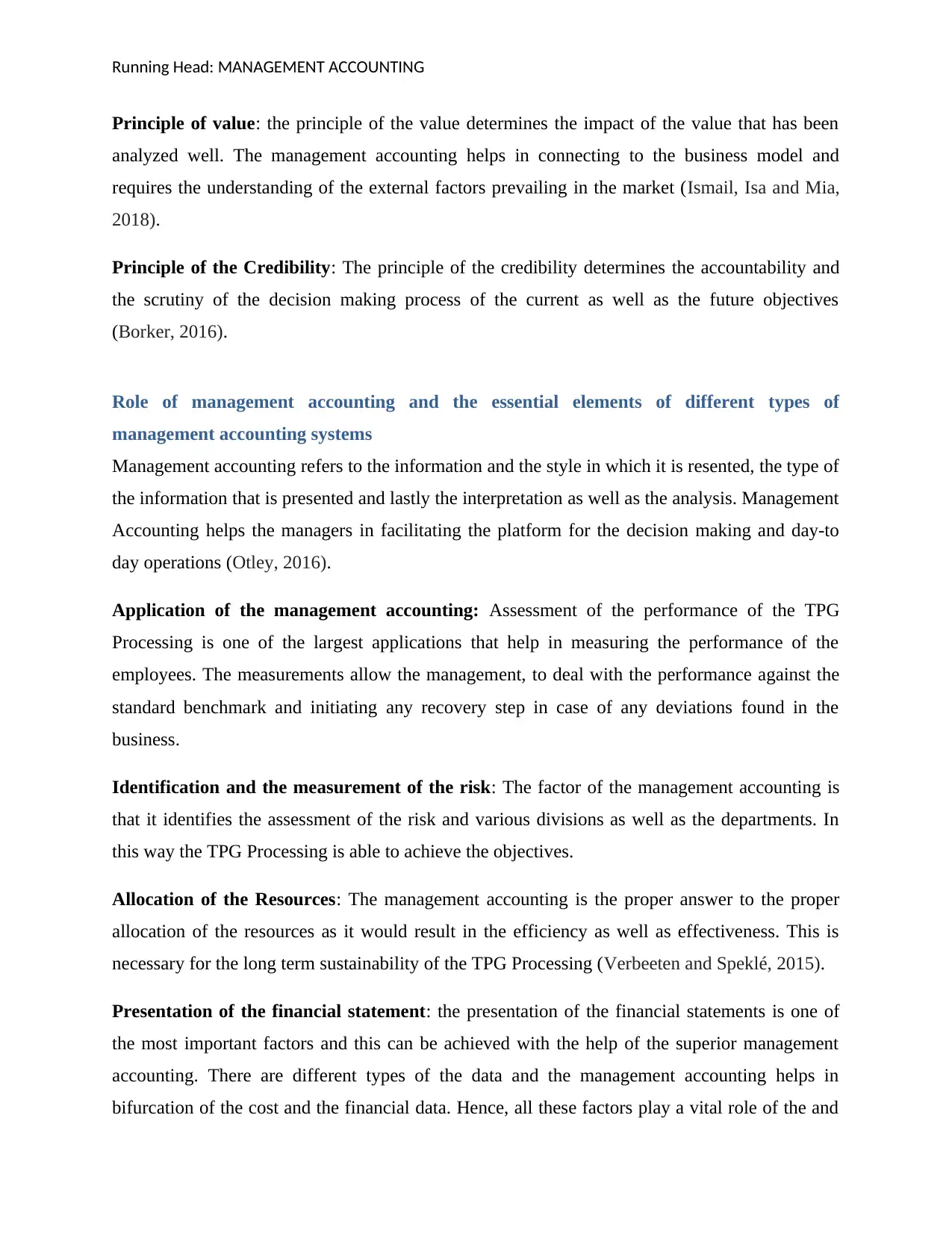
Running Head: MANAGEMENT ACCOUNTING
Principle of value: the principle of the value determines the impact of the value that has been
analyzed well. The management accounting helps in connecting to the business model and
requires the understanding of the external factors prevailing in the market (Ismail, Isa and Mia,
2018).
Principle of the Credibility: The principle of the credibility determines the accountability and
the scrutiny of the decision making process of the current as well as the future objectives
(Borker, 2016).
Role of management accounting and the essential elements of different types of
management accounting systems
Management accounting refers to the information and the style in which it is resented, the type of
the information that is presented and lastly the interpretation as well as the analysis. Management
Accounting helps the managers in facilitating the platform for the decision making and day-to
day operations (Otley, 2016).
Application of the management accounting: Assessment of the performance of the TPG
Processing is one of the largest applications that help in measuring the performance of the
employees. The measurements allow the management, to deal with the performance against the
standard benchmark and initiating any recovery step in case of any deviations found in the
business.
Identification and the measurement of the risk: The factor of the management accounting is
that it identifies the assessment of the risk and various divisions as well as the departments. In
this way the TPG Processing is able to achieve the objectives.
Allocation of the Resources: The management accounting is the proper answer to the proper
allocation of the resources as it would result in the efficiency as well as effectiveness. This is
necessary for the long term sustainability of the TPG Processing (Verbeeten and Speklé, 2015).
Presentation of the financial statement: the presentation of the financial statements is one of
the most important factors and this can be achieved with the help of the superior management
accounting. There are different types of the data and the management accounting helps in
bifurcation of the cost and the financial data. Hence, all these factors play a vital role of the and
Principle of value: the principle of the value determines the impact of the value that has been
analyzed well. The management accounting helps in connecting to the business model and
requires the understanding of the external factors prevailing in the market (Ismail, Isa and Mia,
2018).
Principle of the Credibility: The principle of the credibility determines the accountability and
the scrutiny of the decision making process of the current as well as the future objectives
(Borker, 2016).
Role of management accounting and the essential elements of different types of
management accounting systems
Management accounting refers to the information and the style in which it is resented, the type of
the information that is presented and lastly the interpretation as well as the analysis. Management
Accounting helps the managers in facilitating the platform for the decision making and day-to
day operations (Otley, 2016).
Application of the management accounting: Assessment of the performance of the TPG
Processing is one of the largest applications that help in measuring the performance of the
employees. The measurements allow the management, to deal with the performance against the
standard benchmark and initiating any recovery step in case of any deviations found in the
business.
Identification and the measurement of the risk: The factor of the management accounting is
that it identifies the assessment of the risk and various divisions as well as the departments. In
this way the TPG Processing is able to achieve the objectives.
Allocation of the Resources: The management accounting is the proper answer to the proper
allocation of the resources as it would result in the efficiency as well as effectiveness. This is
necessary for the long term sustainability of the TPG Processing (Verbeeten and Speklé, 2015).
Presentation of the financial statement: the presentation of the financial statements is one of
the most important factors and this can be achieved with the help of the superior management
accounting. There are different types of the data and the management accounting helps in
bifurcation of the cost and the financial data. Hence, all these factors play a vital role of the and
Paraphrase This Document
Need a fresh take? Get an instant paraphrase of this document with our AI Paraphraser
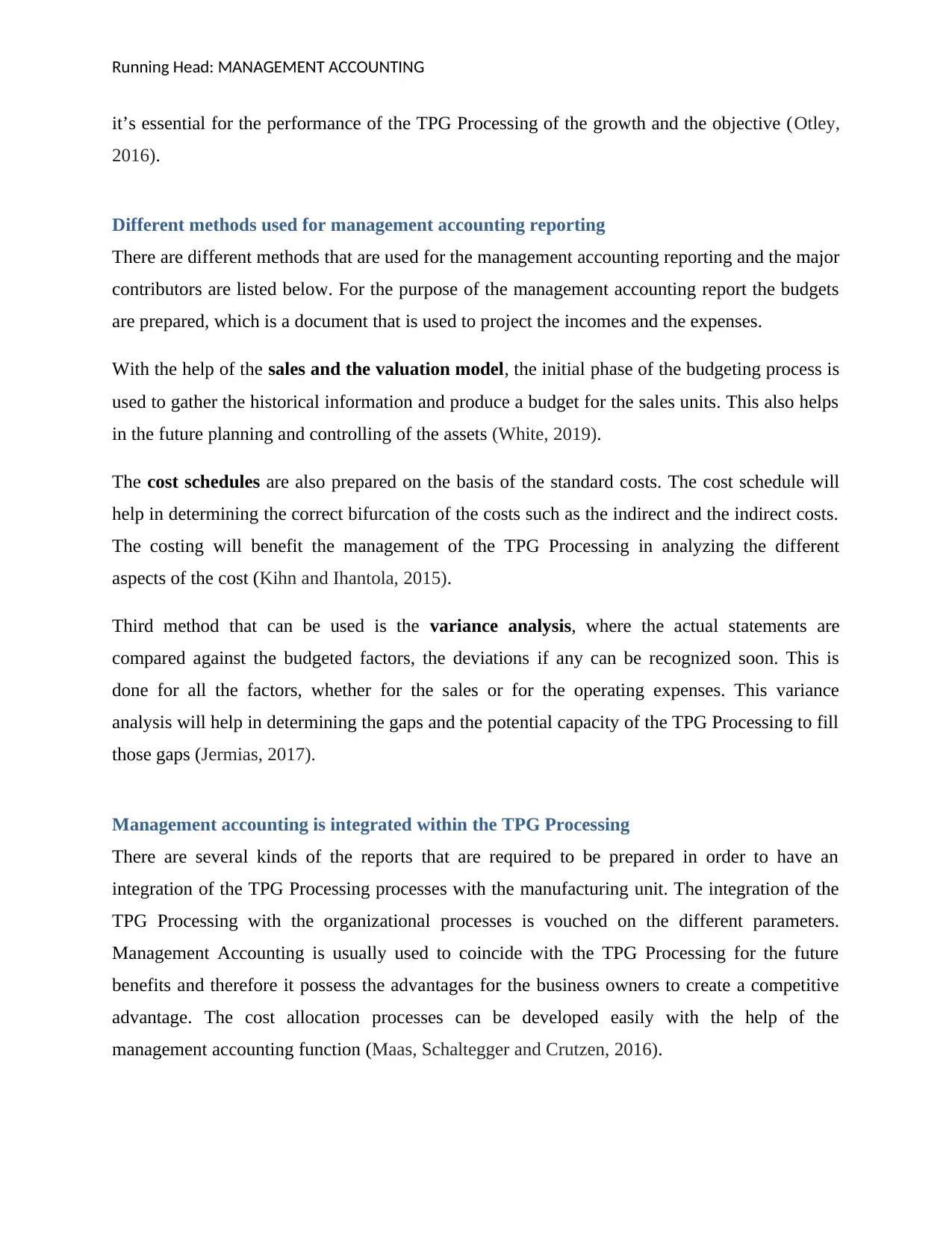
Running Head: MANAGEMENT ACCOUNTING
it’s essential for the performance of the TPG Processing of the growth and the objective (Otley,
2016).
Different methods used for management accounting reporting
There are different methods that are used for the management accounting reporting and the major
contributors are listed below. For the purpose of the management accounting report the budgets
are prepared, which is a document that is used to project the incomes and the expenses.
With the help of the sales and the valuation model, the initial phase of the budgeting process is
used to gather the historical information and produce a budget for the sales units. This also helps
in the future planning and controlling of the assets (White, 2019).
The cost schedules are also prepared on the basis of the standard costs. The cost schedule will
help in determining the correct bifurcation of the costs such as the indirect and the indirect costs.
The costing will benefit the management of the TPG Processing in analyzing the different
aspects of the cost (Kihn and Ihantola, 2015).
Third method that can be used is the variance analysis, where the actual statements are
compared against the budgeted factors, the deviations if any can be recognized soon. This is
done for all the factors, whether for the sales or for the operating expenses. This variance
analysis will help in determining the gaps and the potential capacity of the TPG Processing to fill
those gaps (Jermias, 2017).
Management accounting is integrated within the TPG Processing
There are several kinds of the reports that are required to be prepared in order to have an
integration of the TPG Processing processes with the manufacturing unit. The integration of the
TPG Processing with the organizational processes is vouched on the different parameters.
Management Accounting is usually used to coincide with the TPG Processing for the future
benefits and therefore it possess the advantages for the business owners to create a competitive
advantage. The cost allocation processes can be developed easily with the help of the
management accounting function (Maas, Schaltegger and Crutzen, 2016).
it’s essential for the performance of the TPG Processing of the growth and the objective (Otley,
2016).
Different methods used for management accounting reporting
There are different methods that are used for the management accounting reporting and the major
contributors are listed below. For the purpose of the management accounting report the budgets
are prepared, which is a document that is used to project the incomes and the expenses.
With the help of the sales and the valuation model, the initial phase of the budgeting process is
used to gather the historical information and produce a budget for the sales units. This also helps
in the future planning and controlling of the assets (White, 2019).
The cost schedules are also prepared on the basis of the standard costs. The cost schedule will
help in determining the correct bifurcation of the costs such as the indirect and the indirect costs.
The costing will benefit the management of the TPG Processing in analyzing the different
aspects of the cost (Kihn and Ihantola, 2015).
Third method that can be used is the variance analysis, where the actual statements are
compared against the budgeted factors, the deviations if any can be recognized soon. This is
done for all the factors, whether for the sales or for the operating expenses. This variance
analysis will help in determining the gaps and the potential capacity of the TPG Processing to fill
those gaps (Jermias, 2017).
Management accounting is integrated within the TPG Processing
There are several kinds of the reports that are required to be prepared in order to have an
integration of the TPG Processing processes with the manufacturing unit. The integration of the
TPG Processing with the organizational processes is vouched on the different parameters.
Management Accounting is usually used to coincide with the TPG Processing for the future
benefits and therefore it possess the advantages for the business owners to create a competitive
advantage. The cost allocation processes can be developed easily with the help of the
management accounting function (Maas, Schaltegger and Crutzen, 2016).
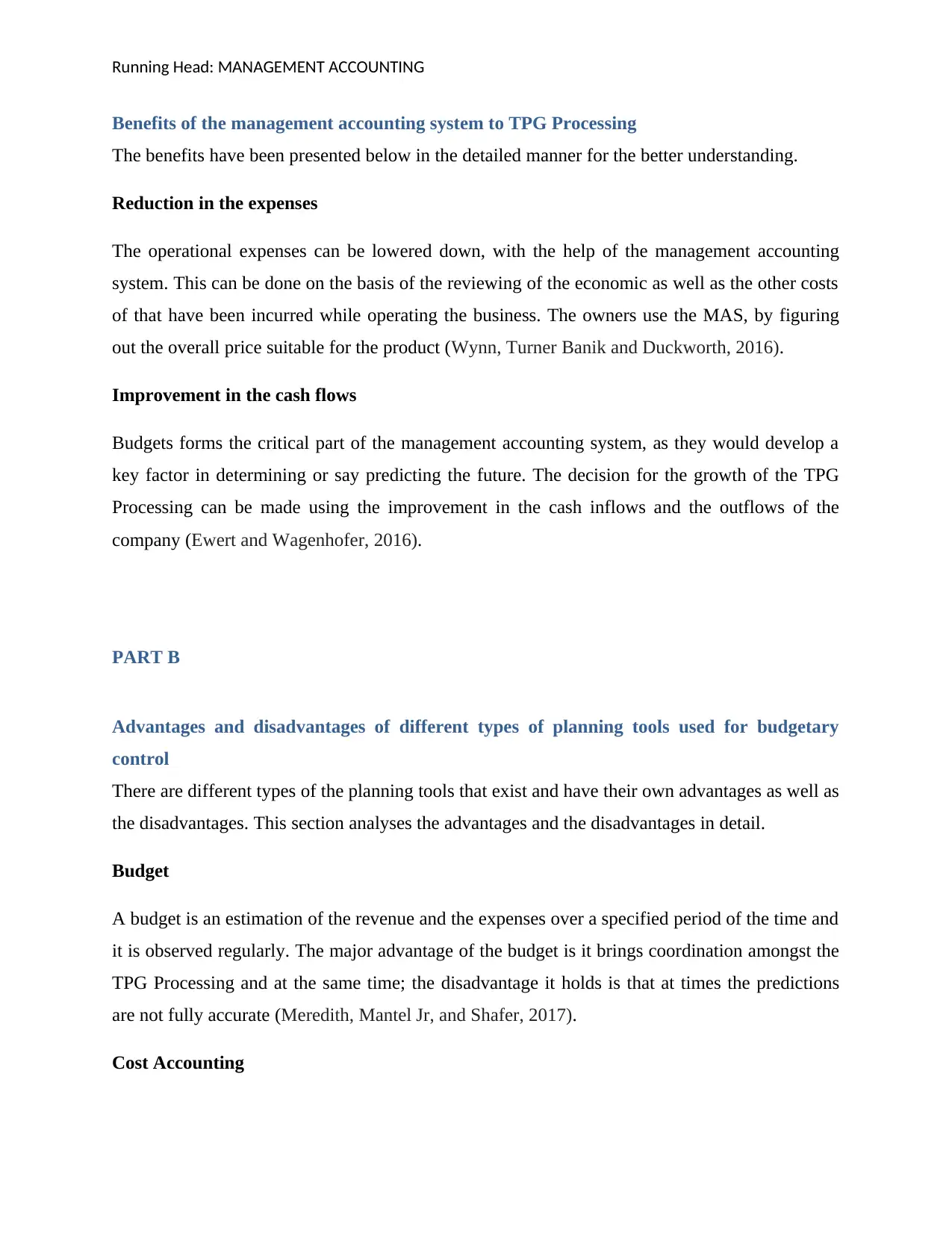
Running Head: MANAGEMENT ACCOUNTING
Benefits of the management accounting system to TPG Processing
The benefits have been presented below in the detailed manner for the better understanding.
Reduction in the expenses
The operational expenses can be lowered down, with the help of the management accounting
system. This can be done on the basis of the reviewing of the economic as well as the other costs
of that have been incurred while operating the business. The owners use the MAS, by figuring
out the overall price suitable for the product (Wynn, Turner Banik and Duckworth, 2016).
Improvement in the cash flows
Budgets forms the critical part of the management accounting system, as they would develop a
key factor in determining or say predicting the future. The decision for the growth of the TPG
Processing can be made using the improvement in the cash inflows and the outflows of the
company (Ewert and Wagenhofer, 2016).
PART B
Advantages and disadvantages of different types of planning tools used for budgetary
control
There are different types of the planning tools that exist and have their own advantages as well as
the disadvantages. This section analyses the advantages and the disadvantages in detail.
Budget
A budget is an estimation of the revenue and the expenses over a specified period of the time and
it is observed regularly. The major advantage of the budget is it brings coordination amongst the
TPG Processing and at the same time; the disadvantage it holds is that at times the predictions
are not fully accurate (Meredith, Mantel Jr, and Shafer, 2017).
Cost Accounting
Benefits of the management accounting system to TPG Processing
The benefits have been presented below in the detailed manner for the better understanding.
Reduction in the expenses
The operational expenses can be lowered down, with the help of the management accounting
system. This can be done on the basis of the reviewing of the economic as well as the other costs
of that have been incurred while operating the business. The owners use the MAS, by figuring
out the overall price suitable for the product (Wynn, Turner Banik and Duckworth, 2016).
Improvement in the cash flows
Budgets forms the critical part of the management accounting system, as they would develop a
key factor in determining or say predicting the future. The decision for the growth of the TPG
Processing can be made using the improvement in the cash inflows and the outflows of the
company (Ewert and Wagenhofer, 2016).
PART B
Advantages and disadvantages of different types of planning tools used for budgetary
control
There are different types of the planning tools that exist and have their own advantages as well as
the disadvantages. This section analyses the advantages and the disadvantages in detail.
Budget
A budget is an estimation of the revenue and the expenses over a specified period of the time and
it is observed regularly. The major advantage of the budget is it brings coordination amongst the
TPG Processing and at the same time; the disadvantage it holds is that at times the predictions
are not fully accurate (Meredith, Mantel Jr, and Shafer, 2017).
Cost Accounting
⊘ This is a preview!⊘
Do you want full access?
Subscribe today to unlock all pages.

Trusted by 1+ million students worldwide
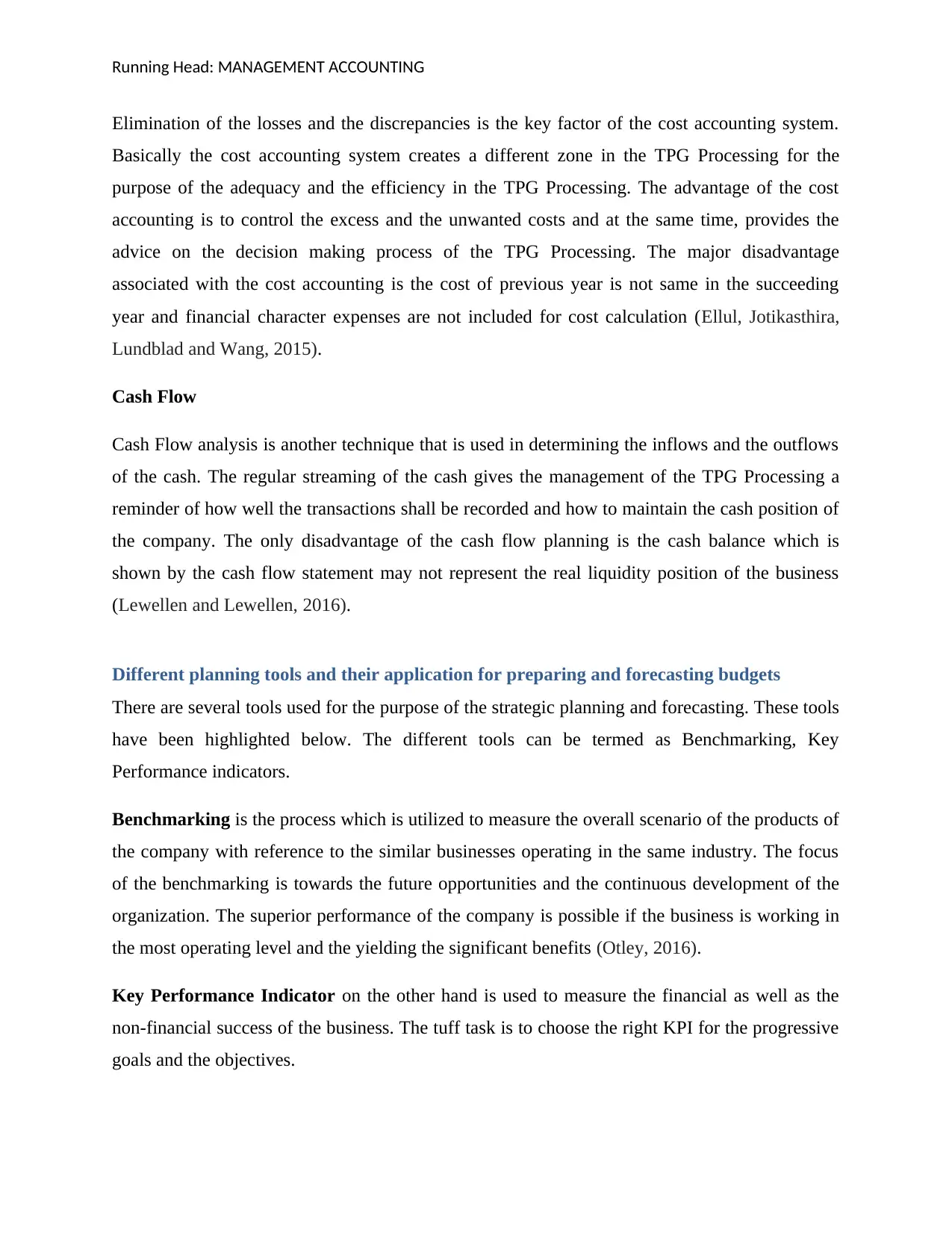
Running Head: MANAGEMENT ACCOUNTING
Elimination of the losses and the discrepancies is the key factor of the cost accounting system.
Basically the cost accounting system creates a different zone in the TPG Processing for the
purpose of the adequacy and the efficiency in the TPG Processing. The advantage of the cost
accounting is to control the excess and the unwanted costs and at the same time, provides the
advice on the decision making process of the TPG Processing. The major disadvantage
associated with the cost accounting is the cost of previous year is not same in the succeeding
year and financial character expenses are not included for cost calculation (Ellul, Jotikasthira,
Lundblad and Wang, 2015).
Cash Flow
Cash Flow analysis is another technique that is used in determining the inflows and the outflows
of the cash. The regular streaming of the cash gives the management of the TPG Processing a
reminder of how well the transactions shall be recorded and how to maintain the cash position of
the company. The only disadvantage of the cash flow planning is the cash balance which is
shown by the cash flow statement may not represent the real liquidity position of the business
(Lewellen and Lewellen, 2016).
Different planning tools and their application for preparing and forecasting budgets
There are several tools used for the purpose of the strategic planning and forecasting. These tools
have been highlighted below. The different tools can be termed as Benchmarking, Key
Performance indicators.
Benchmarking is the process which is utilized to measure the overall scenario of the products of
the company with reference to the similar businesses operating in the same industry. The focus
of the benchmarking is towards the future opportunities and the continuous development of the
organization. The superior performance of the company is possible if the business is working in
the most operating level and the yielding the significant benefits (Otley, 2016).
Key Performance Indicator on the other hand is used to measure the financial as well as the
non-financial success of the business. The tuff task is to choose the right KPI for the progressive
goals and the objectives.
Elimination of the losses and the discrepancies is the key factor of the cost accounting system.
Basically the cost accounting system creates a different zone in the TPG Processing for the
purpose of the adequacy and the efficiency in the TPG Processing. The advantage of the cost
accounting is to control the excess and the unwanted costs and at the same time, provides the
advice on the decision making process of the TPG Processing. The major disadvantage
associated with the cost accounting is the cost of previous year is not same in the succeeding
year and financial character expenses are not included for cost calculation (Ellul, Jotikasthira,
Lundblad and Wang, 2015).
Cash Flow
Cash Flow analysis is another technique that is used in determining the inflows and the outflows
of the cash. The regular streaming of the cash gives the management of the TPG Processing a
reminder of how well the transactions shall be recorded and how to maintain the cash position of
the company. The only disadvantage of the cash flow planning is the cash balance which is
shown by the cash flow statement may not represent the real liquidity position of the business
(Lewellen and Lewellen, 2016).
Different planning tools and their application for preparing and forecasting budgets
There are several tools used for the purpose of the strategic planning and forecasting. These tools
have been highlighted below. The different tools can be termed as Benchmarking, Key
Performance indicators.
Benchmarking is the process which is utilized to measure the overall scenario of the products of
the company with reference to the similar businesses operating in the same industry. The focus
of the benchmarking is towards the future opportunities and the continuous development of the
organization. The superior performance of the company is possible if the business is working in
the most operating level and the yielding the significant benefits (Otley, 2016).
Key Performance Indicator on the other hand is used to measure the financial as well as the
non-financial success of the business. The tuff task is to choose the right KPI for the progressive
goals and the objectives.
Paraphrase This Document
Need a fresh take? Get an instant paraphrase of this document with our AI Paraphraser
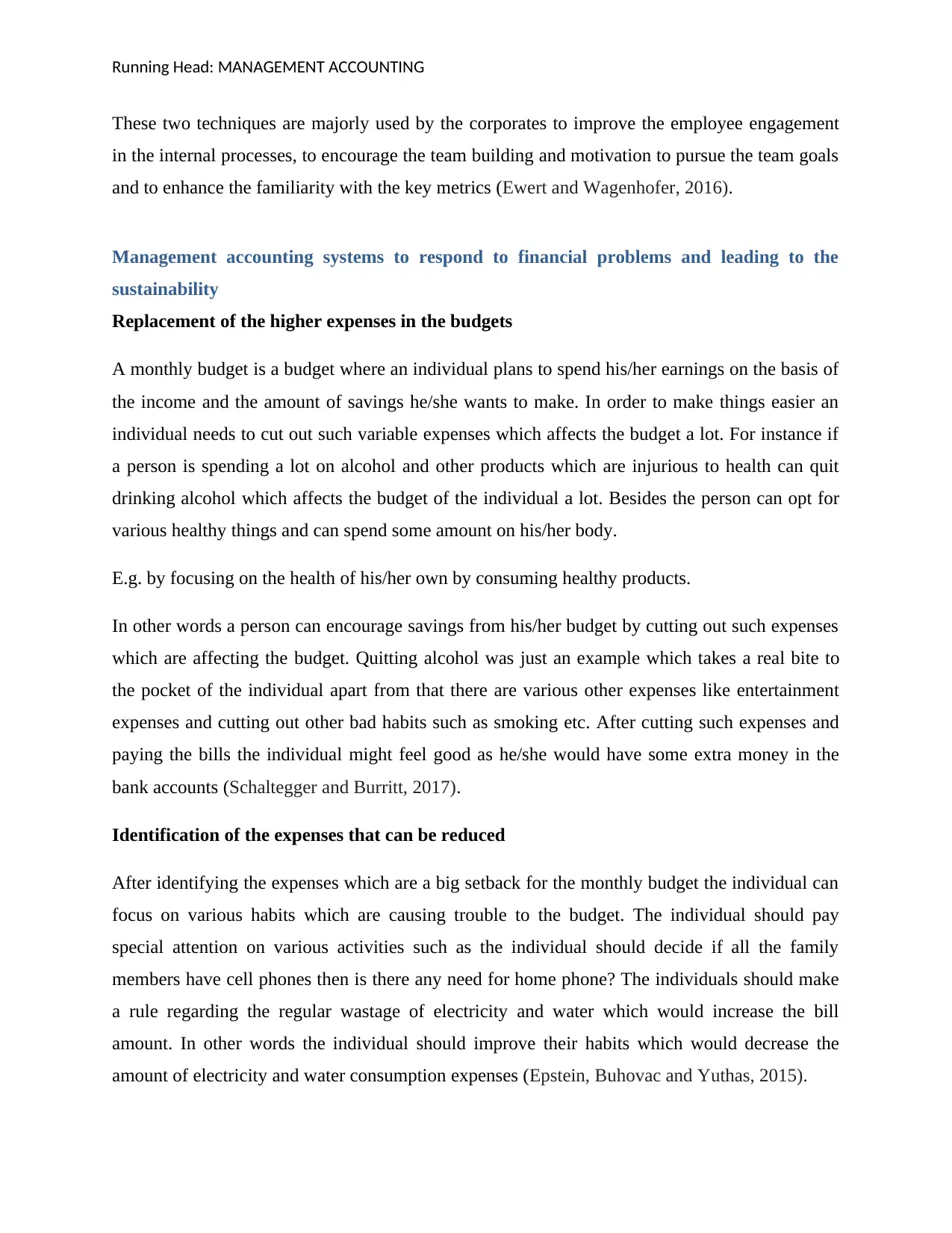
Running Head: MANAGEMENT ACCOUNTING
These two techniques are majorly used by the corporates to improve the employee engagement
in the internal processes, to encourage the team building and motivation to pursue the team goals
and to enhance the familiarity with the key metrics (Ewert and Wagenhofer, 2016).
Management accounting systems to respond to financial problems and leading to the
sustainability
Replacement of the higher expenses in the budgets
A monthly budget is a budget where an individual plans to spend his/her earnings on the basis of
the income and the amount of savings he/she wants to make. In order to make things easier an
individual needs to cut out such variable expenses which affects the budget a lot. For instance if
a person is spending a lot on alcohol and other products which are injurious to health can quit
drinking alcohol which affects the budget of the individual a lot. Besides the person can opt for
various healthy things and can spend some amount on his/her body.
E.g. by focusing on the health of his/her own by consuming healthy products.
In other words a person can encourage savings from his/her budget by cutting out such expenses
which are affecting the budget. Quitting alcohol was just an example which takes a real bite to
the pocket of the individual apart from that there are various other expenses like entertainment
expenses and cutting out other bad habits such as smoking etc. After cutting such expenses and
paying the bills the individual might feel good as he/she would have some extra money in the
bank accounts (Schaltegger and Burritt, 2017).
Identification of the expenses that can be reduced
After identifying the expenses which are a big setback for the monthly budget the individual can
focus on various habits which are causing trouble to the budget. The individual should pay
special attention on various activities such as the individual should decide if all the family
members have cell phones then is there any need for home phone? The individuals should make
a rule regarding the regular wastage of electricity and water which would increase the bill
amount. In other words the individual should improve their habits which would decrease the
amount of electricity and water consumption expenses (Epstein, Buhovac and Yuthas, 2015).
These two techniques are majorly used by the corporates to improve the employee engagement
in the internal processes, to encourage the team building and motivation to pursue the team goals
and to enhance the familiarity with the key metrics (Ewert and Wagenhofer, 2016).
Management accounting systems to respond to financial problems and leading to the
sustainability
Replacement of the higher expenses in the budgets
A monthly budget is a budget where an individual plans to spend his/her earnings on the basis of
the income and the amount of savings he/she wants to make. In order to make things easier an
individual needs to cut out such variable expenses which affects the budget a lot. For instance if
a person is spending a lot on alcohol and other products which are injurious to health can quit
drinking alcohol which affects the budget of the individual a lot. Besides the person can opt for
various healthy things and can spend some amount on his/her body.
E.g. by focusing on the health of his/her own by consuming healthy products.
In other words a person can encourage savings from his/her budget by cutting out such expenses
which are affecting the budget. Quitting alcohol was just an example which takes a real bite to
the pocket of the individual apart from that there are various other expenses like entertainment
expenses and cutting out other bad habits such as smoking etc. After cutting such expenses and
paying the bills the individual might feel good as he/she would have some extra money in the
bank accounts (Schaltegger and Burritt, 2017).
Identification of the expenses that can be reduced
After identifying the expenses which are a big setback for the monthly budget the individual can
focus on various habits which are causing trouble to the budget. The individual should pay
special attention on various activities such as the individual should decide if all the family
members have cell phones then is there any need for home phone? The individuals should make
a rule regarding the regular wastage of electricity and water which would increase the bill
amount. In other words the individual should improve their habits which would decrease the
amount of electricity and water consumption expenses (Epstein, Buhovac and Yuthas, 2015).
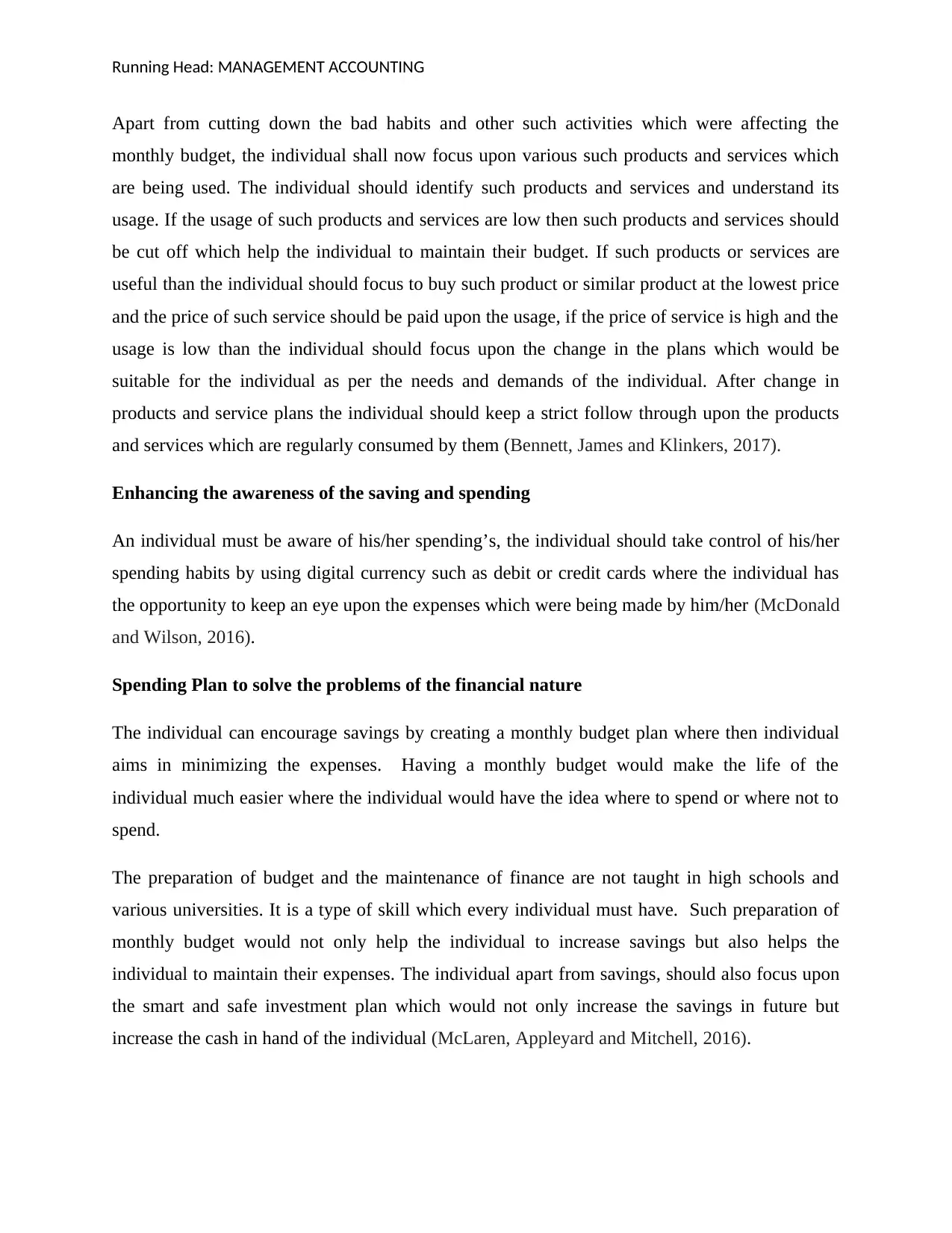
Running Head: MANAGEMENT ACCOUNTING
Apart from cutting down the bad habits and other such activities which were affecting the
monthly budget, the individual shall now focus upon various such products and services which
are being used. The individual should identify such products and services and understand its
usage. If the usage of such products and services are low then such products and services should
be cut off which help the individual to maintain their budget. If such products or services are
useful than the individual should focus to buy such product or similar product at the lowest price
and the price of such service should be paid upon the usage, if the price of service is high and the
usage is low than the individual should focus upon the change in the plans which would be
suitable for the individual as per the needs and demands of the individual. After change in
products and service plans the individual should keep a strict follow through upon the products
and services which are regularly consumed by them (Bennett, James and Klinkers, 2017).
Enhancing the awareness of the saving and spending
An individual must be aware of his/her spending’s, the individual should take control of his/her
spending habits by using digital currency such as debit or credit cards where the individual has
the opportunity to keep an eye upon the expenses which were being made by him/her (McDonald
and Wilson, 2016).
Spending Plan to solve the problems of the financial nature
The individual can encourage savings by creating a monthly budget plan where then individual
aims in minimizing the expenses. Having a monthly budget would make the life of the
individual much easier where the individual would have the idea where to spend or where not to
spend.
The preparation of budget and the maintenance of finance are not taught in high schools and
various universities. It is a type of skill which every individual must have. Such preparation of
monthly budget would not only help the individual to increase savings but also helps the
individual to maintain their expenses. The individual apart from savings, should also focus upon
the smart and safe investment plan which would not only increase the savings in future but
increase the cash in hand of the individual (McLaren, Appleyard and Mitchell, 2016).
Apart from cutting down the bad habits and other such activities which were affecting the
monthly budget, the individual shall now focus upon various such products and services which
are being used. The individual should identify such products and services and understand its
usage. If the usage of such products and services are low then such products and services should
be cut off which help the individual to maintain their budget. If such products or services are
useful than the individual should focus to buy such product or similar product at the lowest price
and the price of such service should be paid upon the usage, if the price of service is high and the
usage is low than the individual should focus upon the change in the plans which would be
suitable for the individual as per the needs and demands of the individual. After change in
products and service plans the individual should keep a strict follow through upon the products
and services which are regularly consumed by them (Bennett, James and Klinkers, 2017).
Enhancing the awareness of the saving and spending
An individual must be aware of his/her spending’s, the individual should take control of his/her
spending habits by using digital currency such as debit or credit cards where the individual has
the opportunity to keep an eye upon the expenses which were being made by him/her (McDonald
and Wilson, 2016).
Spending Plan to solve the problems of the financial nature
The individual can encourage savings by creating a monthly budget plan where then individual
aims in minimizing the expenses. Having a monthly budget would make the life of the
individual much easier where the individual would have the idea where to spend or where not to
spend.
The preparation of budget and the maintenance of finance are not taught in high schools and
various universities. It is a type of skill which every individual must have. Such preparation of
monthly budget would not only help the individual to increase savings but also helps the
individual to maintain their expenses. The individual apart from savings, should also focus upon
the smart and safe investment plan which would not only increase the savings in future but
increase the cash in hand of the individual (McLaren, Appleyard and Mitchell, 2016).
⊘ This is a preview!⊘
Do you want full access?
Subscribe today to unlock all pages.

Trusted by 1+ million students worldwide
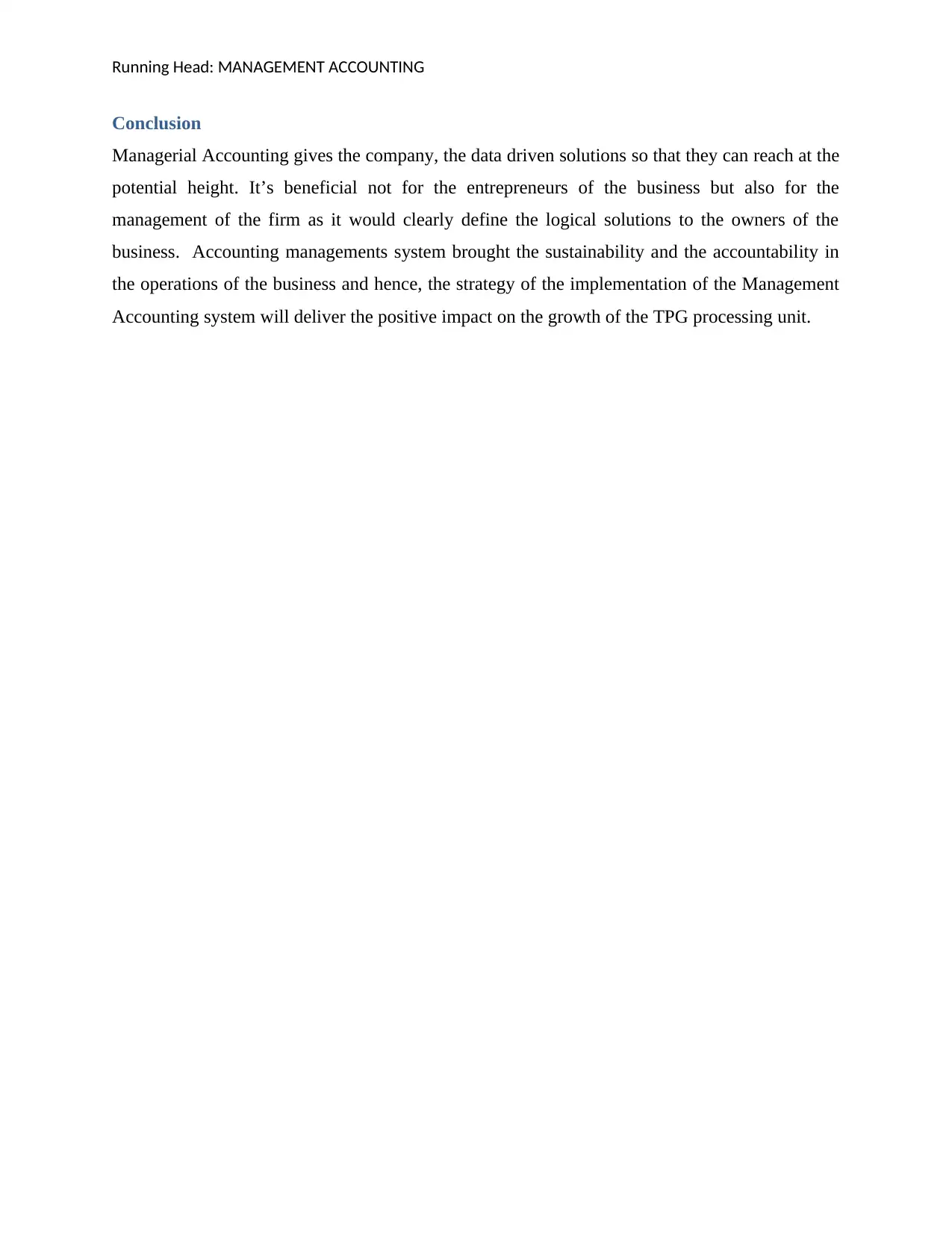
Running Head: MANAGEMENT ACCOUNTING
Conclusion
Managerial Accounting gives the company, the data driven solutions so that they can reach at the
potential height. It’s beneficial not for the entrepreneurs of the business but also for the
management of the firm as it would clearly define the logical solutions to the owners of the
business. Accounting managements system brought the sustainability and the accountability in
the operations of the business and hence, the strategy of the implementation of the Management
Accounting system will deliver the positive impact on the growth of the TPG processing unit.
Conclusion
Managerial Accounting gives the company, the data driven solutions so that they can reach at the
potential height. It’s beneficial not for the entrepreneurs of the business but also for the
management of the firm as it would clearly define the logical solutions to the owners of the
business. Accounting managements system brought the sustainability and the accountability in
the operations of the business and hence, the strategy of the implementation of the Management
Accounting system will deliver the positive impact on the growth of the TPG processing unit.
Paraphrase This Document
Need a fresh take? Get an instant paraphrase of this document with our AI Paraphraser
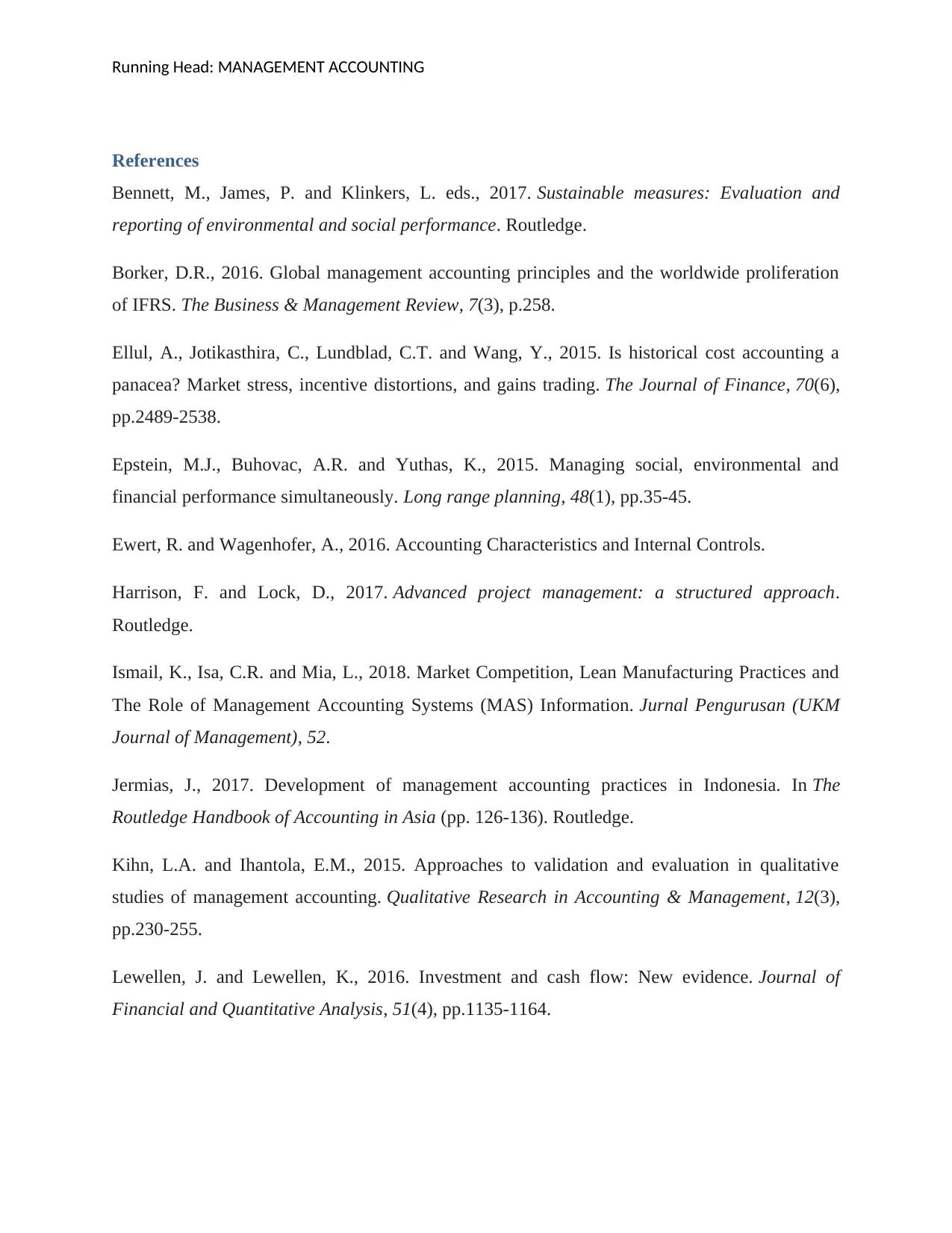
Running Head: MANAGEMENT ACCOUNTING
References
Bennett, M., James, P. and Klinkers, L. eds., 2017. Sustainable measures: Evaluation and
reporting of environmental and social performance. Routledge.
Borker, D.R., 2016. Global management accounting principles and the worldwide proliferation
of IFRS. The Business & Management Review, 7(3), p.258.
Ellul, A., Jotikasthira, C., Lundblad, C.T. and Wang, Y., 2015. Is historical cost accounting a
panacea? Market stress, incentive distortions, and gains trading. The Journal of Finance, 70(6),
pp.2489-2538.
Epstein, M.J., Buhovac, A.R. and Yuthas, K., 2015. Managing social, environmental and
financial performance simultaneously. Long range planning, 48(1), pp.35-45.
Ewert, R. and Wagenhofer, A., 2016. Accounting Characteristics and Internal Controls.
Harrison, F. and Lock, D., 2017. Advanced project management: a structured approach.
Routledge.
Ismail, K., Isa, C.R. and Mia, L., 2018. Market Competition, Lean Manufacturing Practices and
The Role of Management Accounting Systems (MAS) Information. Jurnal Pengurusan (UKM
Journal of Management), 52.
Jermias, J., 2017. Development of management accounting practices in Indonesia. In The
Routledge Handbook of Accounting in Asia (pp. 126-136). Routledge.
Kihn, L.A. and Ihantola, E.M., 2015. Approaches to validation and evaluation in qualitative
studies of management accounting. Qualitative Research in Accounting & Management, 12(3),
pp.230-255.
Lewellen, J. and Lewellen, K., 2016. Investment and cash flow: New evidence. Journal of
Financial and Quantitative Analysis, 51(4), pp.1135-1164.
References
Bennett, M., James, P. and Klinkers, L. eds., 2017. Sustainable measures: Evaluation and
reporting of environmental and social performance. Routledge.
Borker, D.R., 2016. Global management accounting principles and the worldwide proliferation
of IFRS. The Business & Management Review, 7(3), p.258.
Ellul, A., Jotikasthira, C., Lundblad, C.T. and Wang, Y., 2015. Is historical cost accounting a
panacea? Market stress, incentive distortions, and gains trading. The Journal of Finance, 70(6),
pp.2489-2538.
Epstein, M.J., Buhovac, A.R. and Yuthas, K., 2015. Managing social, environmental and
financial performance simultaneously. Long range planning, 48(1), pp.35-45.
Ewert, R. and Wagenhofer, A., 2016. Accounting Characteristics and Internal Controls.
Harrison, F. and Lock, D., 2017. Advanced project management: a structured approach.
Routledge.
Ismail, K., Isa, C.R. and Mia, L., 2018. Market Competition, Lean Manufacturing Practices and
The Role of Management Accounting Systems (MAS) Information. Jurnal Pengurusan (UKM
Journal of Management), 52.
Jermias, J., 2017. Development of management accounting practices in Indonesia. In The
Routledge Handbook of Accounting in Asia (pp. 126-136). Routledge.
Kihn, L.A. and Ihantola, E.M., 2015. Approaches to validation and evaluation in qualitative
studies of management accounting. Qualitative Research in Accounting & Management, 12(3),
pp.230-255.
Lewellen, J. and Lewellen, K., 2016. Investment and cash flow: New evidence. Journal of
Financial and Quantitative Analysis, 51(4), pp.1135-1164.
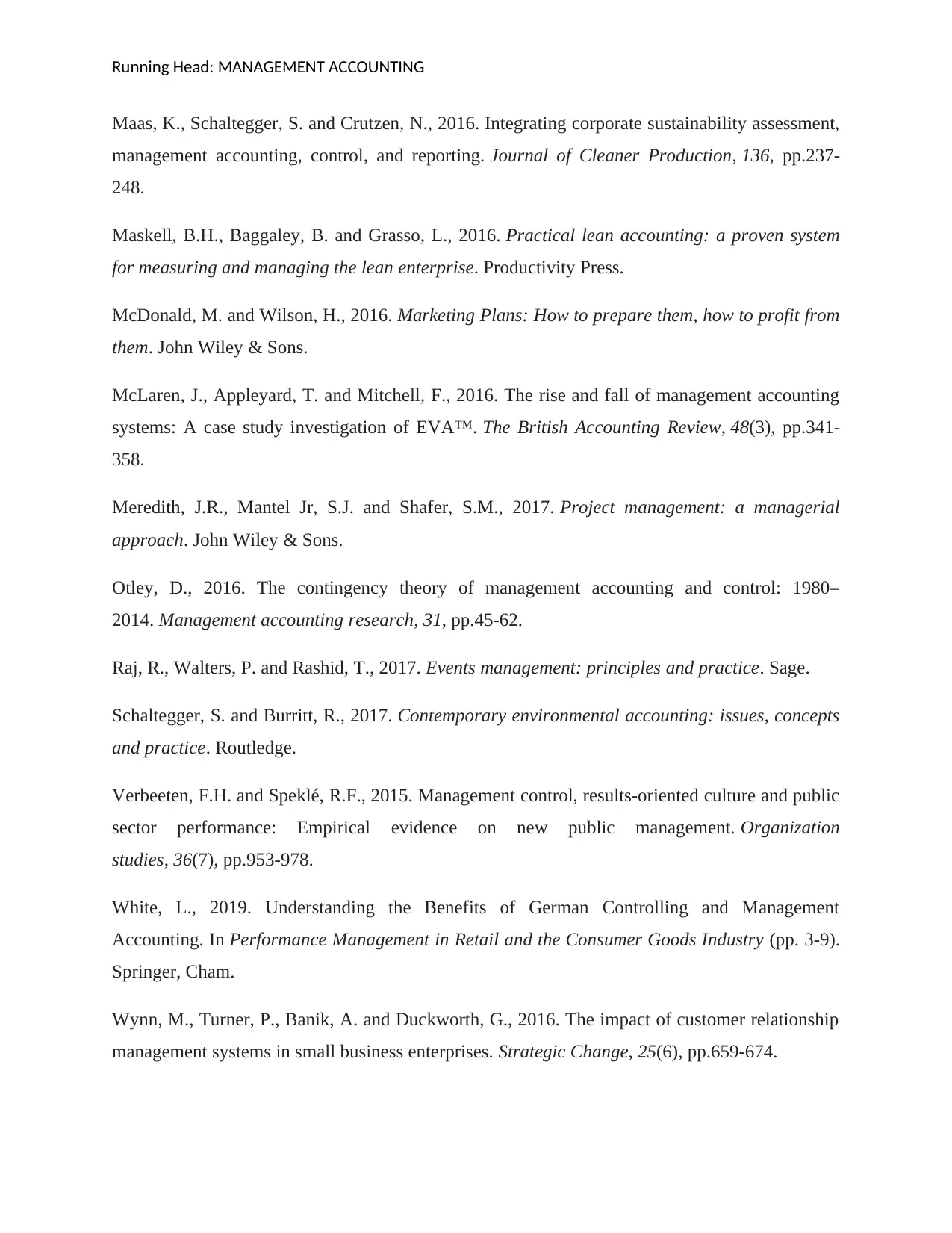
Running Head: MANAGEMENT ACCOUNTING
Maas, K., Schaltegger, S. and Crutzen, N., 2016. Integrating corporate sustainability assessment,
management accounting, control, and reporting. Journal of Cleaner Production, 136, pp.237-
248.
Maskell, B.H., Baggaley, B. and Grasso, L., 2016. Practical lean accounting: a proven system
for measuring and managing the lean enterprise. Productivity Press.
McDonald, M. and Wilson, H., 2016. Marketing Plans: How to prepare them, how to profit from
them. John Wiley & Sons.
McLaren, J., Appleyard, T. and Mitchell, F., 2016. The rise and fall of management accounting
systems: A case study investigation of EVA™. The British Accounting Review, 48(3), pp.341-
358.
Meredith, J.R., Mantel Jr, S.J. and Shafer, S.M., 2017. Project management: a managerial
approach. John Wiley & Sons.
Otley, D., 2016. The contingency theory of management accounting and control: 1980–
2014. Management accounting research, 31, pp.45-62.
Raj, R., Walters, P. and Rashid, T., 2017. Events management: principles and practice. Sage.
Schaltegger, S. and Burritt, R., 2017. Contemporary environmental accounting: issues, concepts
and practice. Routledge.
Verbeeten, F.H. and Speklé, R.F., 2015. Management control, results-oriented culture and public
sector performance: Empirical evidence on new public management. Organization
studies, 36(7), pp.953-978.
White, L., 2019. Understanding the Benefits of German Controlling and Management
Accounting. In Performance Management in Retail and the Consumer Goods Industry (pp. 3-9).
Springer, Cham.
Wynn, M., Turner, P., Banik, A. and Duckworth, G., 2016. The impact of customer relationship
management systems in small business enterprises. Strategic Change, 25(6), pp.659-674.
Maas, K., Schaltegger, S. and Crutzen, N., 2016. Integrating corporate sustainability assessment,
management accounting, control, and reporting. Journal of Cleaner Production, 136, pp.237-
248.
Maskell, B.H., Baggaley, B. and Grasso, L., 2016. Practical lean accounting: a proven system
for measuring and managing the lean enterprise. Productivity Press.
McDonald, M. and Wilson, H., 2016. Marketing Plans: How to prepare them, how to profit from
them. John Wiley & Sons.
McLaren, J., Appleyard, T. and Mitchell, F., 2016. The rise and fall of management accounting
systems: A case study investigation of EVA™. The British Accounting Review, 48(3), pp.341-
358.
Meredith, J.R., Mantel Jr, S.J. and Shafer, S.M., 2017. Project management: a managerial
approach. John Wiley & Sons.
Otley, D., 2016. The contingency theory of management accounting and control: 1980–
2014. Management accounting research, 31, pp.45-62.
Raj, R., Walters, P. and Rashid, T., 2017. Events management: principles and practice. Sage.
Schaltegger, S. and Burritt, R., 2017. Contemporary environmental accounting: issues, concepts
and practice. Routledge.
Verbeeten, F.H. and Speklé, R.F., 2015. Management control, results-oriented culture and public
sector performance: Empirical evidence on new public management. Organization
studies, 36(7), pp.953-978.
White, L., 2019. Understanding the Benefits of German Controlling and Management
Accounting. In Performance Management in Retail and the Consumer Goods Industry (pp. 3-9).
Springer, Cham.
Wynn, M., Turner, P., Banik, A. and Duckworth, G., 2016. The impact of customer relationship
management systems in small business enterprises. Strategic Change, 25(6), pp.659-674.
⊘ This is a preview!⊘
Do you want full access?
Subscribe today to unlock all pages.

Trusted by 1+ million students worldwide
1 out of 12
Related Documents
Your All-in-One AI-Powered Toolkit for Academic Success.
+13062052269
info@desklib.com
Available 24*7 on WhatsApp / Email
![[object Object]](/_next/static/media/star-bottom.7253800d.svg)
Unlock your academic potential
Copyright © 2020–2025 A2Z Services. All Rights Reserved. Developed and managed by ZUCOL.



